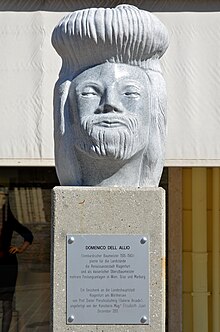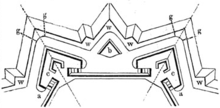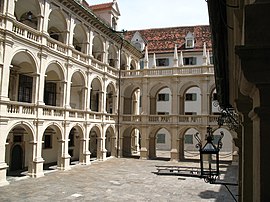Domenico dell'Allio

Domenico dell'Allio ( also: Aglio, del Alio, de Lalio, de Lallio, Illalio, Lalio ) (* around 1515 in Scaria / Italy; † 1563 in Croatia ) was the offspring of a widespread family of builders, master masons, stone masons, sculptors and Plasterers from the Lake Como region , whose activity is attested for over three centuries, from the 16th to the 19th centuries.
Life
Domenico dell'Allio was trained as a master builder in northern Italy and lived in Styria from around 1530 . His father, Martino Allio, worked as a master bricklayer in Radkersburg in 1520 .
The Turkish wars of that time forced Austria and the countries connected to it to renew and improve their fortress architecture . The new Italian fortification system, which had developed in Northern Italy around 1520, was to serve as a model in Inner Austria . The fortress architecture was the main task of the fortress builders from Italy.
One of the most important personalities among them was Domenico dell'Allio, who in 1543 was given the task of renewing the fortifications of Graz and Varaždin under the supervision of the captain for Styria and commander of the Slavonian border, Count Ungnad . Subsequently he also worked in Vienna , Klagenfurt , Fürstenfeld , Feldbach , Radkersburg , Maribor (Marburg), Ptuj (Pettau), Koprivnica (Kopreinitz), Križevci (Kreutz), Brežice (Rann) and at the fortress Ivanić-Grad .
The fortresses were renewed according to the new building principles using the bastion system . The features of the modernization of the fortresses under Italian architects can be seen in lower structures suitable for new fighting techniques. The towers were lower and massive, as cannons were no longer used. At the corners of the walling, bastions were built in place of the angular towers and connected with curtains . The round towers were opened to secure the space for the placement of the cannons. In general, the fortifications such as bastions and defense towers were moved to the outer edge of the city walls in order to keep the battle line as far away from the settlement as possible.
With Domenico dell'Allio's appointment as imperial master builder of the Inner Austrian Lands, the way to Austria was paved for many Italian builders. Domenico used his position to provide compatriots from the Como and Lugano area with well-paid jobs in the construction industry. In addition, because of the explosive political situation, it was of great importance to undertake these structural renovations quickly and in all cities at the same time by experienced builders, and that was the Italians.
The Italian architects were not only specialists in fortress construction, they also left their mark on the mundane. While religious disputes paralyzed the construction of the church at that time, the Italians built numerous town houses, palaces, castles and other structures in the style of the Italian Renaissance . Domenico dell'Allio was also commissioned with the construction of important representative buildings in Graz. The most famous example is the Graz country house , the main wing of which is a work by Domenico and which is one of the most important Renaissance monuments in Austria today. The dell'Allio school is due, among other things, to biforias and triforias , double and triple-coupled arched windows, which were widely used and imitated.
In 1558 Emperor Ferdinand I granted him and his descendants a nobility patent as "architector et artifex insignis, nobleman of the Kingdom of Bohemia".
In the summer of 1563, Domenico set out on an inspection trip to the Croatian-Windy military border, from which he never returned.
Web links
- Domenico dell'Allio. In: arch INFORM .
- Domenico Allio (Italian) in treccani.it, accessed January 31, 2016.
- Domenico dell'Allio in graz.at
- Allio, Domenico dell ' . In: Ulrich Thieme , Felix Becker (Hrsg.): General Lexicon of Fine Artists from Antiquity to the Present . Founded by Ulrich Thieme and Felix Becker. tape 1 : Aa – Antonio de Miraguel . Wilhelm Engelmann, Leipzig 1907, p. 316-317 ( Text Archive - Internet Archive ).
- Domenico dell'Allio. tessinerkuenstler-ineuropa.ch
| personal data | |
|---|---|
| SURNAME | Allio, Domenico dell ' |
| ALTERNATIVE NAMES | Aglio, Domenico; Alio, Domenico del; Lalio, Domenico |
| BRIEF DESCRIPTION | Italian builder |
| DATE OF BIRTH | around 1515 |
| PLACE OF BIRTH | Scaria |
| DATE OF DEATH | 1563 |
| Place of death | Croatia |

